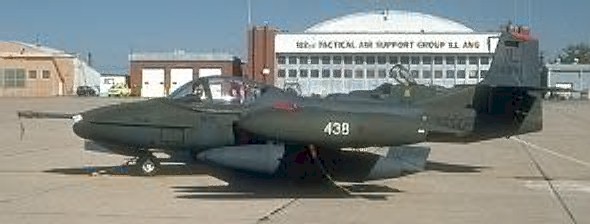Cessna A-37
Dragonfly
(Variants/Other Names: T-37;
OA-37; Cessna Model
318E)

An OA-37B with the
182nd Tactical Air Support Group, Illinois Air National Guard, Peoria, IL
(Photo source unknown. Please contact us if you
deserve credit.)
History: In 1962, the US Air Force’s Special Air Warfare Center decided
to evaluate the T-37 trainer as a future Counter-Insurgency (COIN) light attack aircraft.
The T-37 "Tweet" had been in continuous service with the US Air Force since
1957, and had amassed an excellent service-reliability history. Two T-37Bs were tested
with their original 1,025-lb thrust Continental J69 engines. The aircraft were loaded to a
takeoff weight of 8,700 pounds, almost 33% above their normal maximum, and were
understandably found to be somewhat lacking in performance. Subsequently, each aircraft
was modified with a pair of 2,400-lb thrust General Electric J85-GE-5 turbojets, and were
designated YAT-37Ds. Flight testing showed that the new aircraft
could be safely flown at weights up to 14,000 pounds, which allowed for the carriage of a
wide variety of weapons. Nothing became of the project until 1966, when the US Air
Force’s involvement in Vietnam highlighted the need for a light strike-fighter.
Cessna was contracted to convert 39 T-37B trainers procured from the boneyard at
Davis-Monthan Air Force Base. Delivery of the new aircraft, now called the A-37A
Dragonfly, began in May 1967. In addition to the larger engines, the
aircraft was equipped with eight underwing hard-points and wingtip tanks. The first 25
A-37As underwent operational evaluation in South Vietnam and were eventually transferred
first to the 604th Air Commando Squadron at Bien Hoa, then to the South Vietnamese Air
Force in 1970.
Meanwhile, Cessna had built a prototype called the Model 318E
which, while based on the T-37, had significant differences. Its airframe was stressed for
6 Gs, the fuel load was increased to 507 US gallons (1920 liters) plus 400 more gallons
(1516 liters) in four underwing auxiliary tanks, and it had air-refueling capability. The
aircraft was predictably re-designated the A-37B and, like the
A-model, had a 7.62-mm Gattling Minigun in the nose, gun cameras, and armor protection for
the pilots. It also had self-sealing fuel tanks, a tracking beacon system, and the ability
to directionally track VHF and UHF signals. This prototype of the B-model was first flown
in September 1967 and deliveries began in May 1968.
In addition to service with the US Air Force, the A-37 was supplied in small numbers to
the South Vietnamese Air Force, Turkey, several South American air forces, and the US Air
National Guard, where it remained in service into the early 1990s as an
observation and light-attack derivative called the OA-37B. The A-37 is still
active in South America, where it has soldiered on into the 21st century. Several have
also made their way into the caring hands of private collectors, and it is probable that
airshow audiences will begin to see them appearing on an increasingly regular basis.
Nicknames: Super-Tweet
Specifications (A-37B):
Engines: Two 2,850-lb thrust General Electric J85-GE-17A
turbojets
Weight: Empty 6,210 lbs., Max Takeoff 14,000 lbs.
Wing Span: 35ft. 10.5in.
Length: 28ft. 3.25in.
Height: 8ft. 10.5in.
Performance:
Maximum Speed at 16,000 ft: 525 mph
Maximum Cruising Speed at 25,000:
489 mph
Range: 1010 miles (460 miles with
4,100 lb. external weapon load)
Armament: One GAU-2B/A 7.62-mm (0.3-inch) Minigun, plus various
mixes of general purpose, incendiary or cluster bombs, rocket pods, and gun pods.
Number Built: A-37B: 577; A-37A: 39
Number Still Airworthy: Unknown number in active military service worldwide; at least
4 in
private ownership.
 [
T-37 Flight Report
by Bud Davisson ]
[
T-37 Flight Report
by Bud Davisson ]
Links:
A-37
Dragonfly VH-DLO -- A Dragonfly operated by the Temora Aviation Museum
The A-37 Association --
Lots of A-37 information and links!
Kiwi Aircraft Images: A-37 Dragonfly
Photos Page
"Tweet and the Dragonfly" Site

[Back to Warbird Alley's Main
Page]
All text and photos Copyright 2016 The Doublestar Group, unless otherwise noted.
You may use this page for your own, non-commercial reference purposes only.
 |